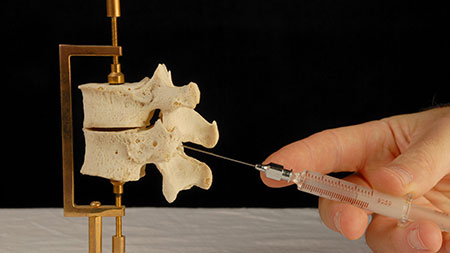This leaflet explains what to expect if you choose to have an epidural catheter placed for pain relief during and after your operation. It has been written by anaesthetists.
WHAT IS AN EPIDURAL?
An epidural is used for giving pain relief. It can be used during surgery to supplement a general anaesthetic, and it is continued after the operation for pain control. The nerves to your lower back pass through an area in your back close to your spine, called the “epidural space”. When you have an epidural, an anaesthetist uses a needle to place a fine plastic tube (an epidural catheter) into the epidural space. Local anaesthetic, and sometimes other pain relief drugs, is put through the epidural catheter.

This lies close to the nerves in your back. As a result, the nerve messages are blocked. This gives you pain relief, which varies in extent according to the amount and type of drug given. The local anaesthetic may cause some numbness as well as pain relief. An epidural pump is used to give pain relief drugs continuously through the epidural catheter. The pump is programmed by your anaesthetists to avoid overdose occurrence. The pain relief lasts as long as the pump is running. When it is stopped, full feeling will return within a few hours.
WHAT ARE THE BENEFITS OF AN EPIDURAL?
If your epidural is working properly, you will have better pain relief than with other methods, particularly when you take a deep breath, cough or move about in the bed. You should need less alternative strong pain relief medicine. This means your breathing will be better, there should be less nausea and vomiting, and you are likely to be more alert. There is also some evidence that other complications of surgery may be reduced, including blood clots in the legs or lung infection. There is some evidence that you may lose less blood with an epidural, which will reduce your chance of needing a blood transfusion.
WHAT IF I DON’T HAVE AN EPIDURAL?
It is your choice. Your anaesthetist will tell you if he/she particularly recommends an epidural, and what alternatives there may be. Other pain relief methods use morphine or similar drugs. These are strong pain relief medicines. These drugs have side effects that include nausea and constipation. Some people become confused when using morphine.
Morphine, or other similar drugs, can be given by mouth, by injection or using a pump that you control yourself (Patient-Controlled Analgesia, commonly known as PCA). Alternatively, there are other ways that local anaesthetic can be given – for example, a nerve block. Every effort will be made to keep you as comfortable as possible.
CAN ANYONE HAVE AN EPIDURAL?
No. An epidural is not possible for some people.
You will need to talk to your anaesthetist if:
- You take blood thinning drugs, such as warfarin;
- You have a blood clotting problem;
- You are allergic to local anaesthetic;
- You have significant deformity of the spine;
- You have an infection in your back;
- You have had previous surgery on the spine with metalwork in your back;
- You have had problems with a spinal or epidural in the past.
HOW IS AN EPIDURAL DONE?
Epidurals can be put in:
- When you are fully awake;
- With sedation (drugs that make feel you sleepy and relaxed);
- During a general anaesthesia.
Your anaesthetist will talk to you about which might be best for you.
The steps for setting up an epidural are:
- A cannula (drip) is placed in a vein in your arm for giving fluid;
- You will be asked to sit up or lie on your side. You will be helped to bend forwards, curving your back as much as you can;
- A small injection of local anaesthetic is given to numb the skin;
- A needle is used to place a thin plastic catheter (tube) into the epidural space in your back. The needle is removed, leaving only the catheter in your back.
HOW WILL THIS FEEL?
The local anaesthetic injection in the skin will hurt briefly. There will then be the feeling of pushing, but usually no more than discomfort as the needle and catheter is inserted. Occasionally, a sharp feeling, like an electric shock, is felt. If this happens, it will be obvious to your anaesthetist. They may ask you where you felt it. A sensation of warmth and numbness gradually develops. For some types of epidural, your legs may feel heavy and become difficult to move. Overall, most people do not find these sensations to be unpleasant, just a bit strange. Feeling and movement will return to normal when the epidural is stopped.
VERY COMMON SIDE-EFFECTS
- Low blood pressure: it is normal for the blood pressure to fall a little when you have an epidural. Your anaesthetist will use fluids and drugs to correct it.
- Inability to pass urine: the nerves to the bladder are affected by the epidural. A catheter (tube) is inserted into the bladder to drain away the urine. This is often needed after major surgery with or without an epidural.
- Itchiness: this is a side-effect of the pain relief drugs that may be used in your epidural. Anti-histamine drugs help, or the drug in the epidural can be changed.
- Feeling sick: this is less common with an epidural than with other pain relief methods. It is treated with anti-sickness medicines.
- Inadequate pain relief: the epidural may not relieve all your pain. Your anaesthetist will decide if it can be improved or if you need to switch to another pain relief method.
COMMON SIDE-EFFECTS
- Headache: headaches happen quite often after surgery. It is possible to get a severe headache after having an epidural. This is because the needle used to place the epidural inadvertently punctured the bag of fluid that bathes the spinal cord. A small amount of fluid leaks out, causing a headache. You will be aware of a severe headache that is worse if you sit up and relieved by lying flat. The staff looking after you should alert the anaesthetic team immediately. You may need specific treatment for the headache.

UNCOMMON COMPLICATIONS
- Slow breathing: Some drugs used in the epidural can cause slow breathing or drowsiness, which requires treatment.
- Nerve damage: temporary. Uncommonly, the needle or epidural catheter can damage nerves. This can give loss of feeling or movement in a large or small area of the lower body. In most people this gets better after a few days, weeks or months.
RARE OR VERY RARE COMPLICATIONS
- Nerve damage: permanent. Permanent nerve damage by the needle or the catheter is rare. A study has shown it happens in between 1 in 6,000 and 1 in 12,000 epidurals used for surgery. Also, rarely, this can happen for other reasons during surgery, related to the surgery itself or for other medical reasons unrelated to the epidural.
- Catheter infection: an infection can occasionally develop around the epidural catheter. If this happens, it will be removed. It is rare for the infection to spread deeper than the skin. Antibiotics may be necessary or, rarely, emergency back surgery. Disabling nerve damage due to an epidural abscess is very rare.
OTHER COMPLICATIONS
- Convulsions (fits), severe breathing difficulty, permanent paraplegia (loss of use of one or more limbs) or death are very rare. The risk of complications should be balanced against the benefits and compared with alternative methods of pain relief. Your anaesthetist can give you more information and help you understand the relative risks.
- Haematoma (blood clot): this is a collection of blood near the nerve, which collects due to damage to a blood vessel by the needle or the catheter. Small amounts of bleeding or bruising are common, and do not cause damage to the nerve. A large haematoma may press on a nerve or on the spinal cord and cause damage. This is a very rare problem, but may require an urgent operation to remove the haematoma and relieve the pressure. If your blood does not clot normally or you take a blood-thinning medicine such as warfarin, heparin or clopidogrel, you are more likely to get a haematoma. In most circumstances you will be asked to stop these medicines, before you have an epidural or spinal injection. If your blood does not clot for other reasons (e.g. haemophilia) you are also at increased risk of this complication. It is important that you tell your anaesthetist about any problems with blood clotting that you have had in the past as you may not be able to have an epidural or spinal injection.
QUESTIONS YOU MAY LIKE TO ASK YOUR ANAESTHETIST
- Why are you recommending an epidural for me?
- What are the advantages and disadvantages of an epidural for me?
- What about the alternatives?
- Who will do my epidural?
- Have you often used this type of pain relief?
- Do I have any special risks?
- How will I feel afterwards?
- How will I feel afterwards if I don’t have an epidural?



